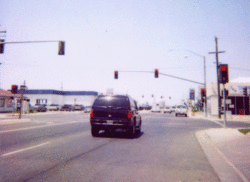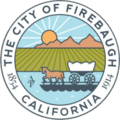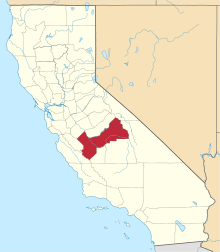Firebaugh, California
| Firebaugh, California | |||||
|---|---|---|---|---|---|
| City | |||||
| City of Firebaugh | |||||
|
Northbound N St. (Highway 33) at 13th Street in 2006. | |||||
| |||||
| Motto: "The Jewel of the San Joaquin!"[1] | |||||
 Location in Fresno County and the state of California | |||||
 Firebaugh, California Location in the United States | |||||
| Coordinates: 36°51′32″N 120°27′22″W / 36.85889°N 120.45611°WCoordinates: 36°51′32″N 120°27′22″W / 36.85889°N 120.45611°W | |||||
| Country | United States of America | ||||
| State | California | ||||
| County | Fresno | ||||
| Incorporated | September 17, 1914[2] | ||||
| Government | |||||
| • Mayor | Craig Knight[3] | ||||
| • Mayor Pro Tem | Chris DeFrancesco[3] | ||||
| • State senator | Jean Fuller (R)[4] | ||||
| • State assemblyman | Joaquin Arambula (D)[5] | ||||
| • CongressMAN | David Valadao (R)[6] | ||||
| Area[7] | |||||
| • Total | 3.519 sq mi (9.114 km2) | ||||
| • Land | 3.462 sq mi (8.967 km2) | ||||
| • Water | 0.057 sq mi (0.148 km2) 1.62% | ||||
| Elevation[8] | 151 ft (46 m) | ||||
| Population (2010) | |||||
| • Total | 7,549 | ||||
| • Density | 2,100/sq mi (830/km2) | ||||
| Time zone | PST (UTC-8) | ||||
| • Summer (DST) | PDT (UTC-7) | ||||
| ZIP code | 93622 | ||||
| Area code(s) | 559 | ||||
| FIPS code | 06-24134 | ||||
| GNIS feature IDs | 277514, 2410507 | ||||
| Website |
www | ||||
Firebaugh (formerly, Firebaugh's Ferry)[9] is a city in Fresno County, California, United States. The population was 7,549 at the 2010 census, up from 5,743 as of the 2000 census. The ZIP Code for the community is 93622 and the city is located inside area code 559. Firebaugh is located on the west side of the San Joaquin River 38 miles (61 km) west of Fresno,[9] at an elevation of 151 feet (46 m).[8] Inside the city, a small commercial district includes the ubiquitous California Central Valley water tank painted with the city's name. State Route 33 (SR 33) runs through downtown just west of center. The San Joaquin Valley Railroad, West Side Subdivision, passes through downtown.
Outside of city, the area is almost entirely agricultural land in all directions. Most fields of irrigated row crops along SR33 are feed crops such as alfalfa.
History

The city is named for Andrew D. Firebaugh (also spelled Fierbaugh),[9] an area entrepreneur.[10] During the Gold Rush, Firebaugh's most famous local enterprise was a ferry boat. It shuttled people across the San Joaquin River. He also built a toll road from Bell Station to Pacheco Pass. The toll road went along a route parallel to present-day State Route 152.
Firebaugh was a station on the Butterfield Overland Stage.[9]
The Firebaugh's Ferry post office operated from 1860 to 1862.[9] The Firebaugh post office opened in 1865.[9]
In the 1880s, the area of Firebaugh was once part of the massive holdings of the Miller and Lux Company. The company had a large sheep operation covering what today is Dos Palos to Mendota.
The city incorporated in 1914.[9]
Geography
According to the United States Census Bureau, the city has a total area of 3.5 square miles (9.1 km2), of which, 3.5 square miles (9.1 km2) of it is land and 0.1 square miles (0.26 km2) of it (1.62%) is water.
Climate
According to the Köppen Climate Classification system, Firebaugh has a semi-arid climate, abbreviated "BSk" on climate maps.[11]
Demographics
| Historical population | |||
|---|---|---|---|
| Census | Pop. | %± | |
| 1930 | 506 | — | |
| 1940 | 704 | 39.1% | |
| 1950 | 821 | 16.6% | |
| 1960 | 2,070 | 152.1% | |
| 1970 | 2,517 | 21.6% | |
| 1980 | 3,740 | 48.6% | |
| 1990 | 4,429 | 18.4% | |
| 2000 | 5,743 | 29.7% | |
| 2010 | 7,549 | 31.4% | |
| Est. 2015 | 8,330 | [12] | 10.3% |
2010
The 2010 United States Census[14] reported that Firebaugh had a population of 7,549. The population density was 2,145.2 people per square mile (828.2/km²). The racial makeup of Firebaugh was 4,715 (62.5%) White, 70 (0.9%) African American, 116 (1.5%) Native American, 40 (0.5%) Asian, 0 (0.0%) Pacific Islander, 2,371 (31.4%) from other races, and 237 (3.1%) from two or more races. Hispanic or Latino of any race were 6,887 persons (91.2%).
The Census reported that 7,536 people (99.8% of the population) lived in households, 13 (0.2%) lived in non-institutionalized group quarters, and 0 (0%) were institutionalized.
There were 1,920 households, out of which 1,208 (62.9%) had children under the age of 18 living in them, 1,179 (61.4%) were opposite-sex married couples living together, 317 (16.5%) had a female householder with no husband present, 182 (9.5%) had a male householder with no wife present. There were 145 (7.6%) unmarried opposite-sex partnerships, and 6 (0.3%) same-sex married couples or partnerships. 197 households (10.3%) were made up of individuals and 95 (4.9%) had someone living alone who was 65 years of age or older. The average household size was 3.93. There were 1,678 families (87.4% of all households); the average family size was 4.17.
The population was spread out with 2,716 people (36.0%) under the age of 18, 914 people (12.1%) aged 18 to 24, 1,923 people (25.5%) aged 25 to 44, 1,504 people (19.9%) aged 45 to 64, and 492 people (6.5%) who were 65 years of age or older. The median age was 26.4 years. For every 100 females there were 106.3 males. For every 100 females age 18 and over, there were 104.4 males.
There were 2,096 housing units at an average density of 595.6 per square mile (230.0/km²), of which 1,008 (52.5%) were owner-occupied, and 912 (47.5%) were occupied by renters. The homeowner vacancy rate was 1.6%; the rental vacancy rate was 3.6%. 4,105 people (54.4% of the population) lived in owner-occupied housing units and 3,431 people (45.4%) lived in rental housing units.
2000
As of the census[15] of 2000, there were 5,743 people, 1,418 households, and 1,246 families residing in the city. The population density was 2,030.6 people per square mile (783.5/km²). There were 1,581 housing units at an average density of 559.0 per square mile (215.7/km²). The racial makeup of the city was 43.60% White, 1.15% Black or African American, 1.36% Native American, 0.87% Asian, 0.02% Pacific Islander, 48.51% from other races, and 4.49% from two or more races. 87.52% of the population were Hispanic or Latino of any race.
There were 1,418 households out of which 59.5% had children under the age of 18 living with them, 66.4% were married couples living together, 14.7% had a female householder with no husband present, and 12.1% were non-families. 9.4% of all households were made up of individuals and 4.9% had someone living alone who was 65 years of age or older. The average household size was 4.01 and the average family size was 4.28.
In the city the population was spread out with 39.3% under the age of 18, 10.8% from 18 to 24, 28.7% from 25 to 44, 14.7% from 45 to 64, and 6.4% who were 65 years of age or older. The median age was 25 years. For every 100 females there were 108.3 males. For every 100 females age 18 and over, there were 105.7 males.
The median income for a household in the city was $31,533, and the median income for a family was $33,018. Males had a median income of $24,213 versus $17,829 for females. The per capita income for the city was $9,290. About 20.0% of families and 22.5% of the population were below the poverty line, including 27.9% of those under age 18 and 24.3% of those age 65 or over.
In popular culture
- On their 1985 album Wönderful, the Circle Jerks, an influential Los Angeles-based punk band, recorded a song entitled "Firebaugh". The song's lyrics portray a dystopian vision of racial tension, violence, alcoholism, and boredom. Listeners are warned, "If your car breaks down, don't take a tow to Firebaugh..."[16]
- Wells Fargo Bank, one of the major banks in California, periodically runs television commercials set in late 19th-century California and featuring their trademark stage coach. "Firebaugh's Ferry" is sometimes listed as a stage coach stop.
- The video for the 1999 single "The Greatest" by Kenny Rogers was filmed at the baseball field known as "dunkle field" in Firebaugh. Many of the spectators featured in the video were local residents from Firebaugh.
References
- ↑ https://commons.wikimedia.org/wiki/File:Firebuaghbk2-1024x667.jpg
- ↑ "California Cities by Incorporation Date" (Word). California Association of Local Agency Formation Commissions. Retrieved April 6, 2013.
- 1 2 "City Council". City of Firebaugh. Retrieved April 6, 2013.
- ↑ "Senators". State of California. Retrieved April 6, 2013.
- ↑ "Members Assembly". State of California. Retrieved April 6, 2013.
- ↑ "California's 21st Congressional District - Representatives & District Map". Civic Impulse, LLC. Retrieved April 5, 2013.
- ↑ "2010 Census U.S. Gazetteer Files – Places – California". United States Census Bureau.
- 1 2 "Firebaugh". Geographic Names Information System. United States Geological Survey.
- 1 2 3 4 5 6 7 Durham, David L. (1998). California's Geographic Names: A Gazetteer of Historic and Modern Names of the State. Clovis, Calif.: Word Dancer Press. ISBN 1-884995-14-4.
- ↑ Myer, Chuck, report: Pacheco Past: A History of the Gateway to Santa Clara County, (San Jose, California: Pioneers of Santa Clara County, 1992), page 3.
- ↑ Climate Summary for Firebaugh, California
- ↑ "Annual Estimates of the Resident Population for Incorporated Places: April 1, 2010 to July 1, 2015". Retrieved July 2, 2016.
- ↑ "Census of Population and Housing". Census.gov. Retrieved June 4, 2015.
- ↑ "2010 Census Interactive Population Search: CA - Firebaugh city". U.S. Census Bureau. Retrieved July 12, 2014.
- ↑ "American FactFinder". United States Census Bureau. Retrieved 2008-01-31.
- ↑ Wönderful album overview


.png)
